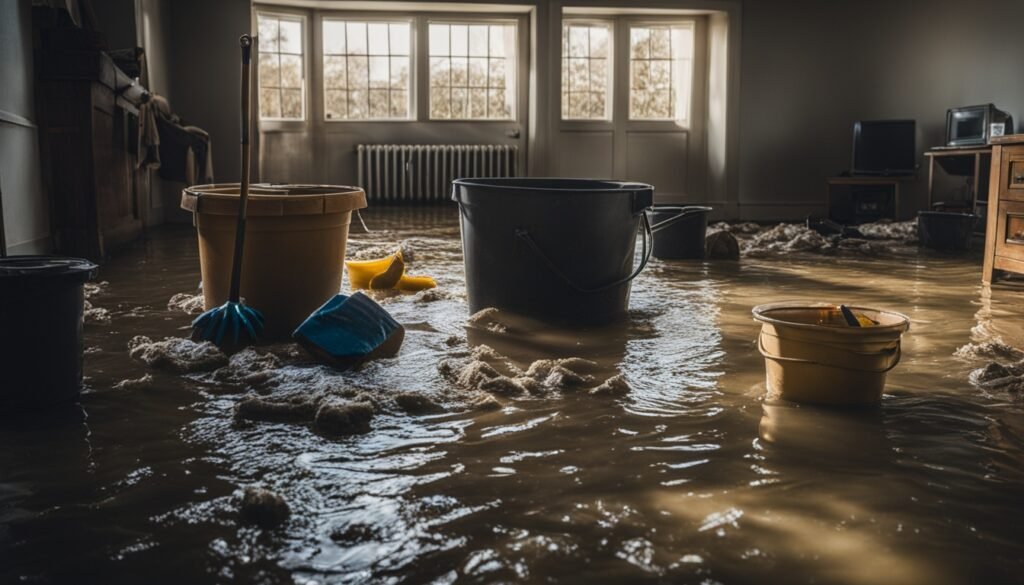Floods can wreak havoc on your home and turn your life upside down. They destroy your belongings and pose health risks with still water and mold. But with knowledge and prep, you can fix your home and find calm again.
Key Takeaways:
- Take safety precautions before starting the cleanup process to protect yourself and your family.
- Document the flood damage thoroughly for insurance claims, including photos, videos, and a detailed list of damaged items.
- Contact your flood insurance company as soon as possible to initiate the recovery process.
- Organize a cleanup crew consisting of family, friends, or professional services to assist with the restoration.
- Begin the cleanup by removing standing water, sorting through debris, and assessing the structural integrity of your property.
Ensuring Safety Before Starting the Cleanup Process
Before cleaning up after a flood, making sure you are safe is key. Protecting yourself and your family is top priority. Here are a few important safety tips to follow:
Wait for Official Clearance
Don’t rush back to your property after a flood. Wait until local authorities say it’s safe. They will check if it’s okay for people to return. Only go back when you get the all-clear from them.
Wear Protective Gear
It’s vital to wear the right gear during cleanup. You’ll need waterproof boots, gloves, safety goggles, and a hard hat. They help protect against cuts, dirty water, and objects that might fall.
Beware of Potential Hazards
Know about dangers to keep yourself safe. Floods can weaken buildings and expose wires. They can also make water harmful by adding bacteria, viruses, and chemicals. Be careful and stay away from water that might be bad.
Protect Your Respiratory System
Mold and bacteria can be a big problem after floods. It’s important to keep your lungs safe. Use a mask or respirator to not breathe in bad stuff. This protects you from things in the air that can hurt your lungs.
Understanding Persistent Risks
Even when the flood is over, some dangers remain. These include mold that’s hard to see, damage to buildings, and electrical issues. Always be careful and focus on staying safe while you clean and fix things.
Keep these safety tips in mind during flood cleanup to stay safe. Doing this means you’ll be better off as you recover. It’s better to be safe now for a smoother fix-up later.
https://www.youtube.com/watch?v=R-N4TWU51c4
Documenting the Flood Damage and Contacting Your Insurance Company
When the water goes down, take pictures to show how bad the damage is. This helps you file a claim with your insurance. Showing your flood insurance company evidence can get you better coverage for fixing things.
Follow these steps:
- Document the Damage: Snap photos and shoot videos of the damage from different views. Capture structural harm, water marks, and small but important details. These visuals are key evidence of how much was damaged.
- Keep Damaged Items: Save items ruined by the flood to show your insurance. They prove how the flood hurt your place.
- Create a Detailed List: List everything damaged in your home. Note their value if you can. This helps your insurance see the full damage and cover costs accurately.
- Contact Your Insurance Company: Call your flood insurance provider quickly to start your claim. Give them your photos, videos, and the list of what’s damaged.
When calling your insurance, ask important questions. Here are a few:
- What steps do I follow to file a claim for flood damage?
- What does my flood insurance cover exactly?
- Can I make any immediate repairs or do something to lessen more harm?
Taking pictures of the damage and quickly getting in touch with your insurer helps. It makes claiming smoother and may help get the funds needed to fix your home after a flood.

Organizing a Cleanup Crew and Initiating the Property Cleanup
After a flood, putting together a cleanup crew is key. You can include family, friends, volunteers, or professional services. It’s a good idea to hire experts if you’re dealing with a lot of damage or mold. Make sure everyone has protective gear to stay safe.
Begin by getting rid of any standing water on your property. Use pumps or vacuums designed for wet conditions to do this. Then, sort through the mess left by the flood. Divide items into those you can keep and those you can’t. This makes cleanup easier.
Start the cleanup by removing dirt and debris. This makes your property safer and easier to work on. Next, look at how much damage there is. Figure out what repairs are needed.


